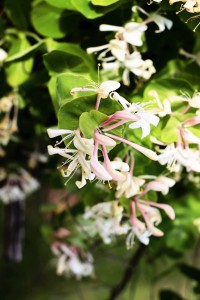Our Chief Growth Officer, Caitlyn Scaggs, explains how a run along her favorite jogging trail led to deeper understanding of volatiles and odor analysis.

After a long day, nothing is more relaxing than going for a run. Working at Polymer Solutions, I’m fortunate enough to live in an area that is as rich in natural beauty as it is in technology. My favorite running spot is the Huckleberry Trail. This jogging trail parallels a creek, gives glimpses at the gorgeous countryside and also has portions flanked by honeysuckle on both sides. On a hot summer’s day, the floral smell can be intense–in a good way of course.
One day in particular, as I was running along, I began to wonder why the flowers seemed so much more fragrant on a hot day as opposed to some of my cooler day or evening runs. Since I have access to scientists who can answer that kind of question, I posed it the next day to a knowledgeable co-worker. The answer was simple: flowers “communicate” with pollinators and potential predators through the release of volatiles.
Volatiles are molecules that have a low molecular weight, which makes them vaporize easily into the air. In nature, volatiles account for the beautiful aroma of honeysuckle. When volatiles vaporize off any object and make their way through the air to your nose, you perceive them as a scent.
Both natural and synthetic materials give off volatiles. Synthetic volatiles are responsible for the new-car smell you get when you slide into that flashy model in the car dealer’s showroom.
People have successfully used volatiles to flavor food and create fragrances for thousands of years — even before we knew how volatiles worked. Synthetic volatiles can also communicate information about the substances they’re a part of — if you know how to speak their language. Scientists can interpret the language of volatiles through odor analysis, which employs a variety of tests, such as headspace gas chromatography with mass spectrometry (GC-MS) and solid phase micro-extraction (SPME).
Testing for the presence of volatiles can be useful in a variety of applications. For example, does anyone remember the case of the stinky cheese puffs that we blogged about a while ago? In that instance, testing for volatiles allowed us to help a packaging manufacturer demonstrate that the food, and not our client’s polyester bags, was responsible for a bad smell. In another situation, some of our own sales materials came under fire for having a bad odor. We used GC-MS to show the smell came from a type of paint that had been used to coat a plastic sales sheet.
To conduct GC-MS testing on a smelly sample that’s either liquid or solid, we seal a sample in a headspace vial and then heat everything up to excite the volatiles from a solid or liquid phase into the gas phase. We then sample the gas in the headspace to determine the presence and concentration of volatiles.
Odor analysis is among the most fun types of projects we work on. Odor analysis can help identify problems or impurities in food, packaging, recycled products such as carpeting, to name some examples. We’ve even used it to identify the source of a bad smell coming from mulch on a playground! While I don’t need odor analysis to identify the fragrant honeysuckle along my favorite running route, as far as materials testing goes, GC-MS is one of the most useful, versatile and reliable tests available when we need to explain and understand an odor.

